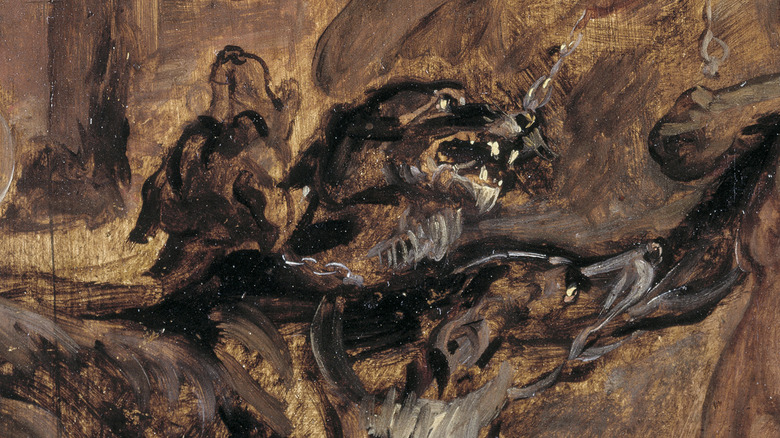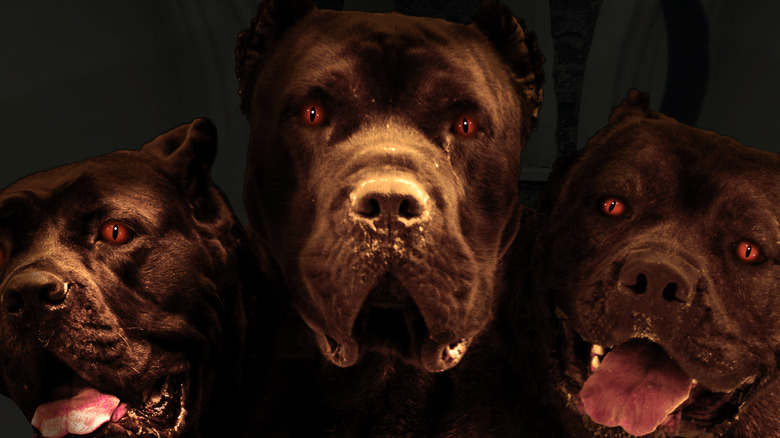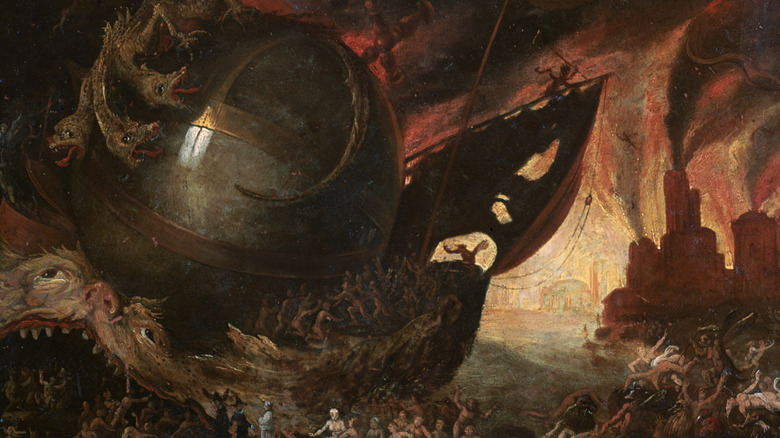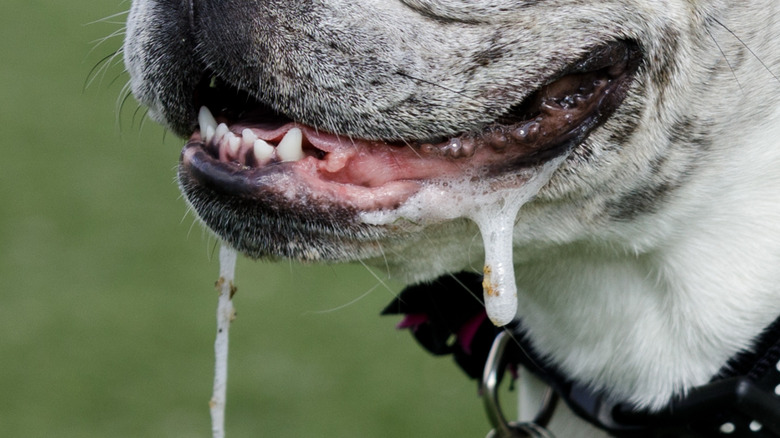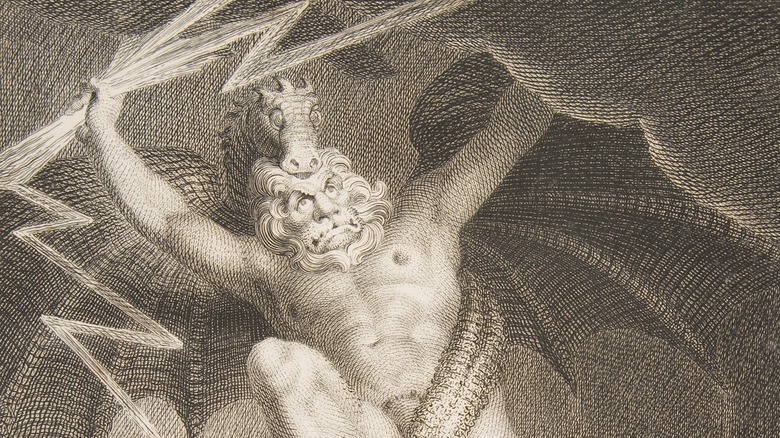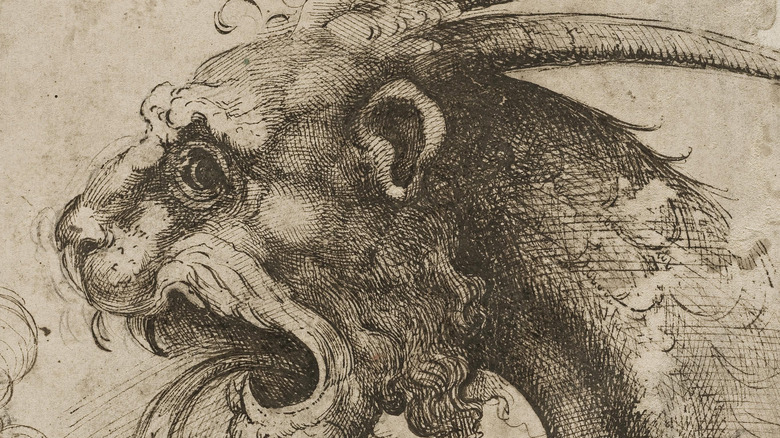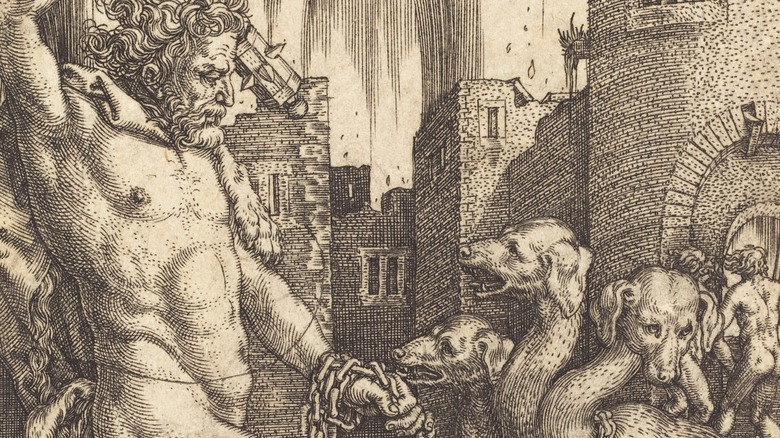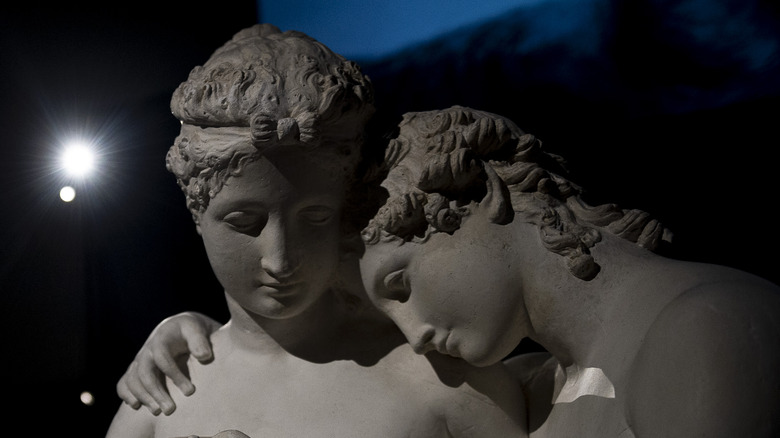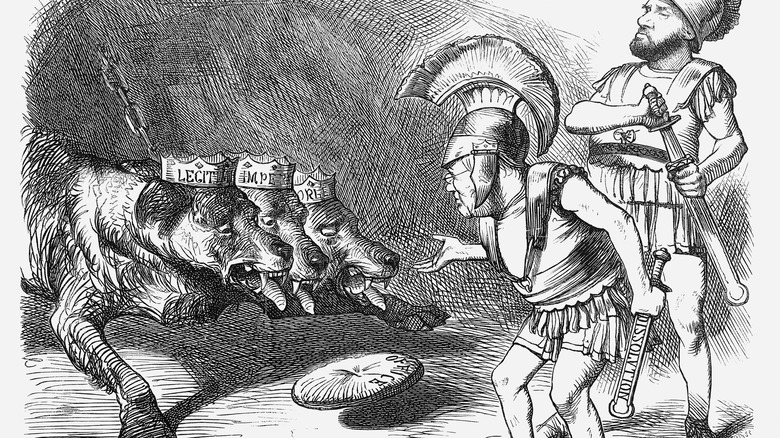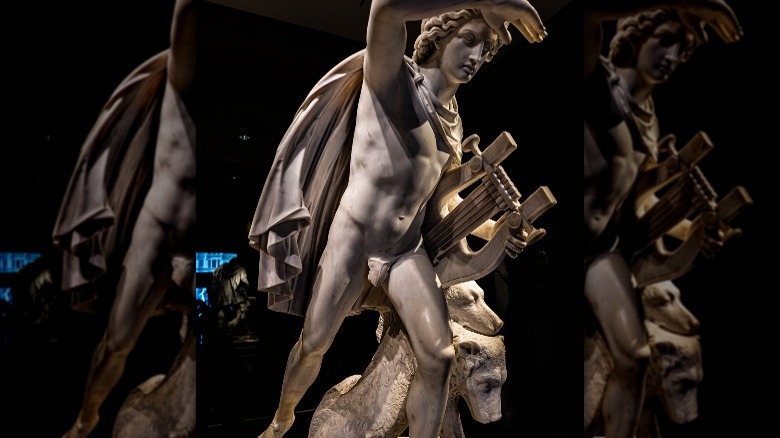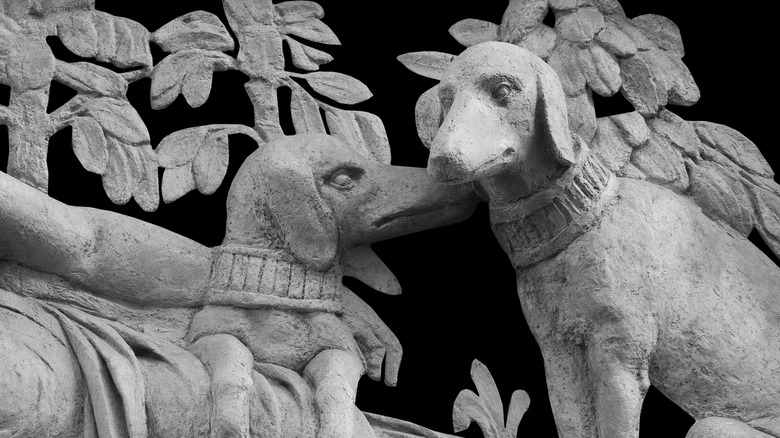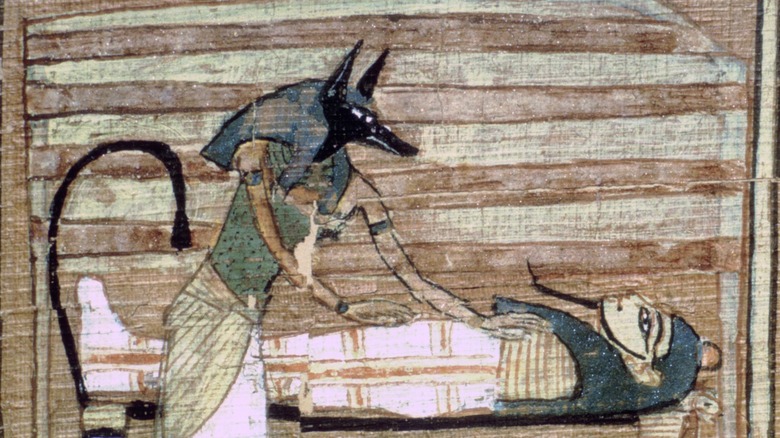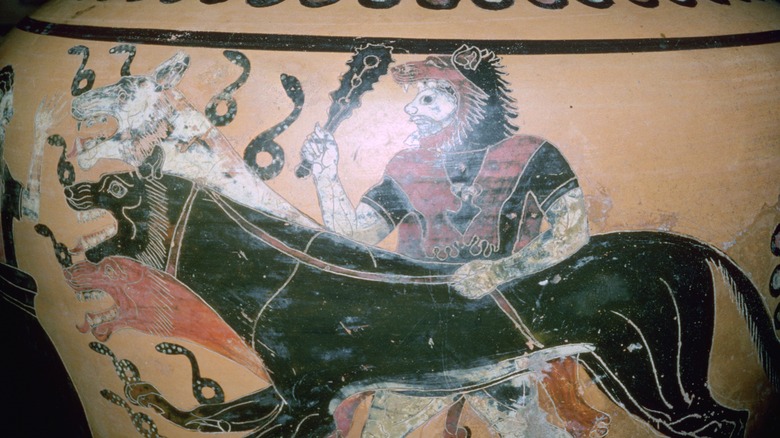The Myth Of Cerberus Explained
Greco-Roman mythology has no shortage of epic quests, terrifying monsters, or heroes willing to face them. One of the challenges many great mythological heroes had to face was the famous three-headed guard dog of the underworld.
As explained in "Bouncing down to the underworld: Classical Katabasis in The Ground Beneath Her Feet," the ancient Greek term "katabasis" refers to the act of journeying into the land of the dead. Many of the most iconic heroes of Greek and Roman myth make this perilous journey to the underword. In some legends, even finding the entrance to the underworld is a challenge. Once they get there, however, trying not to be devoured by Cerberus can be an even more substantial obstacle. Some of the most exciting adventures of famous heroes like Hercules, Aeneas, and Orpheus involve finding a way around Cerberus -– either with brute force or charm.
The image of a three-headed dog guarding the gates to the underworld is one that has remained fascinating to audiences for thousands of years -– but the legends around Cerberus have greater connections to life and death in the ancient world than may be immediately obvious. This is the myth of Cerberus explained.
A Three-Headed Dog
Cerberus' name means "demon from the pit," and his appearance lives up to the name. He is often described as a large black guard dog chained to the gates of the underworld (via "Cerberus"). There are many different depictions of Cerberus' appearance, but his most notable and consistent feature is that he is a hound with three heads.
In reality, there has never been a three-headed animal documented (although individuals with two heads have occurred in animals and even humans, as detailed by Time). But in mythology, especially in Greco-Roman mythology, Cerberus is far from alone. There are many examples of multi-headed creatures, from the mix-and-match monster the Chimera to the terrifying Hydra.
Some depictions give Cerberus more unique and fantastical features. While he often is described as a massive dog with three matching heads, some stories state that one of his heads appears to be a lion, sometimes with a terrifying mane of snakes. Some sources state that Cerberus has 50 heads. As noted by Maurice Bloomfield's "Cerberus, the Dog of Hades: The History of an Idea," he is frequently depicted as having a snake for a tail, as well.
The Greek Underworld
Cerberus was owned by Hades, the reluctant ruler of the underworld. As described by "Heroes, Gods and Monsters of the Greek Myths," the dead were rowed across the river Styx by the ferryman Charon –- as long as they had a coin to pay for the trip. Once they made it across, they would reach the gate of the underworld, where Hades' loyal hound stood guard. Once inside, the dead could only whisper and "twittered like bats" as they drifted around the dark fields. Some, who had truly angered the gods, were given frustrating eternal tasks as punishment.
Hades is often depicted as a jealous and possessive god who wanted all of the spirits of the dead for himself. Cerberus' role was to keep them all inside the underworld –- and to keep the living out. Often, great heroes in Greek and Roman mythology had to go into the underworld, either for knowledge or to try to help a loved one escape. First, they had to get by Cerberus, however, which was one of the most potentially deadly tasks in ancient myth.
Poison Spit
A huge guard dog with three times the jaws of a normal animal might seem like enough security, but as noted by "Cerberus," the "hound of Hades" had one more deadly weapon to keep the living out of the underworld: his spit.
Some legends describe Cerberus' drool as poisonous. When his three heads slobbered and his saliva touched the ground, a purple flower known as aconite or wolfsbane grew from the spot. The ancient world regarded these flowers as being highly poisonous. Ovid's "Metamorphoses" depicts the "juice" of wolfsbane as being the substance that Athena used to transform Arachne into the first spider.
Cerberus is not the only mythological creature in Greek and Roman mythology to be poisonous to humans. As noted by Britannica, the Hydra had poison blood so potent that the hero Hercules was able to use it to make his arrows more deadly long after the monster was dead.
Cerberus' Parents
Cerberus' parents were both formidable and feared creatures. While neither resemble hounds, they have their own fascinating features.
His mother is called Echidna. As detailed in "Melusine the Serpent Goddess in A.S. Byatt's Possession and in Mythology," Echidna is depicted as a beautiful woman -– from the waist up. It's possible that Cerberus inherited his snake fur and tail from his mother, because below the waist she has the body of a snake. Like Cerberus, Echidna does not spend her time above ground. The immortal and unaging Echidna's lair is in a deep, underground cave system. She eats only raw meat.
Even in rare depictions where Cerberus had 50 heads, he had nothing on his father: the 100-headed Typhon. "Heroes, Gods and Monsters of the Greek Myths" describes Typhon as being half-snake, like his wife Echidna. Unlike her, he was also half-donkey and had massive wings like a bat. He was said to be able to spit fire. As explained by Britannica, in some versions of the legend, Zeus, the king of the gods, trapped Typhon under Mount Etna where he continued to cause volcanic eruptions from underground. In other versions, Typhon was condemned to the underworld.
Cerberus' littermates
Cerberus was not the only child of Echidna and Typhon. One was the Hydra. Like his parents, he is snake-like, but unlike his flying father and cave-dwelling mother, he lived underwater. Like his brother Cerberus, he had many heads, though, as noted by Britannica, the number varies depending on the legend. This is largely because when a hero tried to kill the Hydra by decapitating one of his heads, two would sprout up in its place. To make things more difficult, one of the Hydra's heads was immortal. The only hero to succeed in destroying the Hydra was Hercules -– who would eventually also face Cerberus.
Another was the Chimera. She is depicted as having a lion's head at the end of her neck and a goat's head growing out of her back. Like Cerberus, she also had a snake for a tail. A pair of dragons were also among Echidna and Typhon's brood. As noted by Britannica, although they did not look like Cerberus, they were also guards. Rather than the gates to the underworld, they guarded golden apples and the golden fleece.
Of the many monstrous children of Echidna and Typhon, the one who most resembles Cerberus is Orthus. Orthus is depicted as a two-headed hound who guarded the cattle belonging to a monster named Geryon (via Tufts University). The hero Hercules was on a quest to capture some of the cattle; Orthus attacked Hercules and was killed. Cerberus' encounter with the demigod ended differently.
Hercules captures Cerberus
The famous Greek mythological hero Hercules was set a series of 12 heroic tasks he hads to perform, known as the labors of Hercules. As detailed by Tufts University's Perseus Digital Library, many of the demigod's most dangerous exploits involved Cerberus' littermates -– and finally Cerberus himself.
During his second labor, he defeated the Hydra by preventing his heads from regrowing with a burning torch, then burying his immortal head deep underground where it could do no harm. During Hercules' 10th labor, he killed Cerberus' two-headed brother Orthus. In the 11th, Hercules tricked the Titan Atlas into bringing him the golden apples guarded by one of Cerberus' dragon brothers. Hercules also faced the Nemean Lion, which was sometimes described as Typhon's child.
Hercules' final task is considered the most dangerous of all. He was told to travel to the underworld to capture Cerberus. On his journey, Hercules fought numerous monsters and spirits, but none as dangerous as Cerberus. Finally, Hercules reached Hades, the king of the underworld, and asked him for permission to take Cerberus to the mortal world. Hades agreed, but only if the hero could capture Cerberus himself, without using any weapons or tools. Hercules wrestled with Cerberus, fighting all three of the hound's heads at once. Although Cerberus succeeded in biting Hercules with his snake tail, he was ultimately captured. The hero brought Cerberus to the mortal word to prove that he had succeeded. Afterwards, he returned Cerberus safely to the underworld.
Psyche charms Cerberus
While many mortal heroes were charged with getting past Cerberus to enter the underworld, not all of them had to physically overpower the hound of Hades. Like Hercules, the human woman Psyche was given a series of nearly impossible tasks, including going to the underworld.
As retold in "Cerberus," the beautiful mortal woman Psyche was married to Cupid, a god of love. His jealous mother Aphrodite repeatedly asked Psyche to do nearly impossible things for her, hoping to prove that Psyche was an unfit bride for her son. The last and most difficult favor Aphrodite asked was for Psyche to travel to the underworld to borrow makeup from Hades' wife. Psyche agreed.
Psyche brought some food to distract Cerberus, but it would turn out that she didn't need it. As soon as the terrifying hound saw her, he was enchanted. Rather than attacking and eating her, as Cerberus generally did with intruders, he became as friendly and playful as an ordinary dog.
Aeneas Feeds Cerberus
The mythical hero Aeneas is best known for his central role in Virgil's "Aeneid," about the history and founding of Rome. Like many other classical heroes, his journey took him to the underworld. Aeneas was there to be given a prophecy by his dead father. In order to find his father's spirit, however, he would have to find a way to get past the underworld's guard dog.
Cerberus is especially frighteningly depicted in the "Aeneid." He is large enough to fill a massive cavern, has a mane of writing snakes, and his intensely loud "triple-throated roar" echoed throughout the underworld. Aeneas brought a secret weapon to avoid being devoured by the "ravenous" dog –- honey cakes.
The "loaf with honeyed herbs" was more than just a snack to distract the guard dog. It was laced with something to make him sleep. While Cerberus was unconscious, Aeneas was able to sneak through "hell's portal" and into the underworld to continue his quest.
A sop to Cerberus
Cerberus' penchant for honey cakes wasn't discovered by Aeneas -– in fact, it was common knowledge in the Ancient Greek world and influenced funeral customs.
As noted by "Marriage, birth and death in the beliefs and religious customs of ancient Greeks," the burial customs in Ancient Greece included things believed to assist the dead in entering the underworld. This could include coins (or a drink) to pay the ferryman to take the dead across the River Styx, and honey cakes for Cerberus.
This custom of bringing Cerberus something to eat in order to pass by him unharmed led to the modern phrase "a sop to Cerberus." As explained by The New York Times, in modern usage, "a sop for Cerberus" refers to appeasement, or "an insignificant price to pay for averting much discomfort." Metaphorically, it compares pacifying an aggrieved party by offering them a small thing that they want instead of causing open hostilities with giving Cerberus his favorite food to avoid being eaten yourself.
Orpheus plays for Cerberus
Not every hero came prepared with food for Cerberus, but there were other ways to distract the hound of Hades, as the hero Orpheus discovered.
Orpheus, as retold by "Heroes, Gods and Monsters of the Greek Myths," was a musician who was the son of a muse and taught to play the lyre by Apollo himself. He married a woman named Eurydice, but a year after their wedding day, she stepped into a nest of poisonous snakes and was killed. Orpheus decided to go into the underworld to get her back.
When he reached the gates, Cerberus snarled at him, getting ready to rip him to pieces. Instead of running away, Orpheus began to play his lyre. He played a hunting song for Cerberus, to remind him of a life he might have had as an ordinary dog –- one-headed and running through the forest after animals. Cerberus listened to the song, and then went to sleep to dream of life as a normal dog, and Orpheus was able to enter the underworld.
Ancient Greek and Roman Dogs
Ordinary life for a dog in the classical period was obviously highly different from Cerberus', living deep underground surrounded by ghosts. However, dogs did hold an important role in household life –- so it's no surprise that a dog held such a place of prominence in the afterlife, as well.
As detailed by "Dogs in the Ancient World" from the World History Encyclopedia, many dogs were guard dogs like Cerberus, but they could also be hunting dogs (as Orpheus reminded Cerberus) and companions to their owners. The ancient Greeks are believed to have invented the ever popular spiked collar for their dogs. Researcher Adrienne Mayor (via Smithsonian) explained that there were unique and peculiar methods for selecting a puppy that would grow into a strong dog. Romans were encouraged to put the litter into apparent peril, and it was believed that the mother dog would rescue them in order of their strength and hardiness. The first rescued puppy would be the best choice.
Puppies were often named for traits that their owners valued in dogs, like strength and speed. The most common names for dogs translate to things like "tracker," "growler," and "riot."
Counterparts in other pantheons
While the hound of Hades is one of the most famous supernatural canines, the idea of a dog standing guard at the entrance to the underworld or defending the boundaries between life and death is not unique to Cerberus.
The Finnish mythological dog Surma also guarded the land of the dead for its ruling deities. Like Cerberus, his tail was described as a snake. Also like Cerberus, legends about the ferocious dog in the afterlife influenced burial customs. According to "Cerberus," some were buried with clubs so they could fight their way past Surma. In Norse mythology, the gate to the underworld — Helheim — is guarded by a dog named Garm. Sometimes Garm is depicted with multiple heads, like Cerberus.
While Garm, Surma, and Cerberus were simple guard dogs for the rulers of the underworld, some cultures viewed dogs as having a more powerful role in the afterlife. In ancient Egyptian mythology, the black-dog-headed — or jackal-headed — god Anubis was a worshipped death god. Instead of attacking the living or the dead to ensure they stayed in the correct realms, Anubis was the being who determined where the dead belonged. He would lead the spirits of the dead to the afterlife, and then weigh their hearts to determine if they had been good enough in life to remain. If not, he fed their hearts to his own monstrous beast: the crocodile-headed Ammit.
Depictions in art and modern interpretations
Descriptions of Cerberus have captured the imaginations of storytellers and artists for thousands of years. Cerberus' appearance varies considerably depending on the depiction, but the image of a massive black dog with three heads has become a standard found from classical poetry and art to modern fantasy novels and films.
Along with the Greek and Roman poets who told stories about Cerberus, artists frequently depicted him in statues and painted him on vases -– particularly illustrating his fight with the hero Hercules. As noted in "Cerberus, the Dog of Hades," he is mentioned by writers across centuries, including Ovid and Shakespeare.
Modern fantasy writers and filmmakers still use the image of the three-headed guard dog. Modern audiences may be familiar with the massive three-headed guard dog in Harry Potter (named Fluffy rather than Cerberus). The popular middle-grade series "Percy Jacson and the Olympians" also features many Greek mythological figures, including Cerberus –- who is depicted as a lonely but playful rottweiler.
